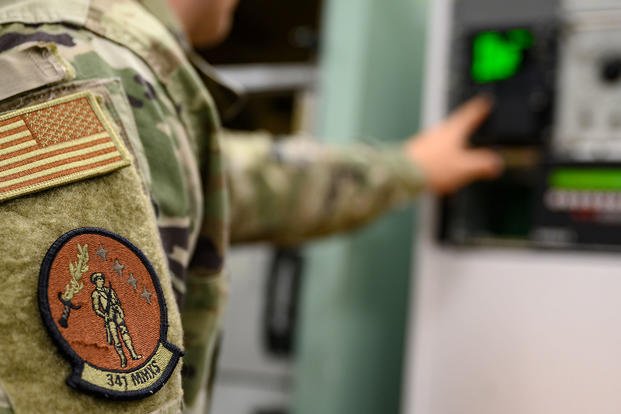A new independent academic study examining a form of blood cancer among those who served at Malmstrom Air Force Base, Montana, has found that service members were diagnosed at younger ages compared to the wider population, a notable revelation as that community fears their cancers and illnesses could be tied to their service.
The findings were published in a research paper this month by a doctoral candidate and professor at the University of North Carolina at Chapel Hill who did statistical analysis into self-reported cancer data from the Torchlight Initiative — a grassroots nonprofit involving current and former service members who worked with America’s intercontinental ballistic missiles.
The research analyzed 18 cases within the nonprofit’s registration. The main illness examined was cases of non-Hodgkin lymphoma, a cancer known as NHL that starts in white blood cells and can affect the immune system.
Read Next: 48 Hours with Marines and Soldiers on the US Southern Border
“The results demonstrate a statistically significant increase in NHL diagnoses among missileers in the later decades, with observed rates surpassing expected benchmarks,” according to the research paper. “The study also finds that the median age of diagnosis is significantly younger for the study population compared to national averages.”
The independent academic research comes as the Air Force continues to pursue its own wide-ranging health study into cancer concerns among service members who worked at America’s intercontinental ballistic missile bases. Many advocates for that community are fighting for increased attention to illnesses and cancers, and are calling for extended benefits coverage under the PACT Act, a 2022 law that mostly covered veterans sickened by toxic exposure in war zones.
“The ICBM community is taking casualties. Now, we have the mathematical evidence to back it up,” Alex Ruiz, the co-director of the Torchlight Initiative, told Military.com in a statement, adding that the findings “should drive immediate mitigation of environmental risks, discussion of including the ICBM community in the PACT Act, and education amongst the exposed individuals.”
In a Military.com investigative series last year, it was revealed that prior studies and warnings into cancer cases among missileers two decades ago went ignored, making it harder for many to diagnose their illnesses later in life and seek medical benefits connected to their service.
The new study acknowledges the media attention put on the health issue.
“The analysis was motivated by reports of elevated cancer diagnoses within the intercontinental ballistic missile (ICBM) community, specifically targeting NHL cases due to initial media focus and data collection through the Torchlight Initiative,” according to the study.
In July, the Torchlight Initiative shared an early, pre-published study with Military.com from the same researchers in the latest study. Those findings, shortly after being shared, were taken off the nonprofit’s website because the research had not gone through a proper security and policy review with the Air Force prior to being publicized.
That July pre-published report strongly “underscored the exceptionally low likelihood of such events occurring purely by chance,” citing a probability of 2.1 in 1,000 trillion. Notably, the published version detailed the “limitations such as small sample size and estimation uncertainty” had on results, detailing a much smaller increase of expected NHL cases but still identifies the risks facing the missileer community.
“With a conservative approach, to include a conservative correction factor, we nonetheless found statistical significance and temporal trends within the overall analysis,” the April research paper detailed. “Ultimately, these results suggest potential underlying risk factors or exposures unique to this population, particularly those entering in later decades, and necessitates further epidemiological scrutiny.”
Spokespeople for Air Force Global Strike Command declined to comment on the latest independent study findings.
While initial results in the Air Force’s widespread study showed potentially elevated rates of breast cancer and prostate cancer, the latest findings incorporate data from the National Death Index, a centralized database of death records, that “did not identify statistically elevated mortality” among the missile community.
The next step the Air Force is taking is to examine state cancer registries and a larger pool of data from across the country. Some changes have happened since the start of the study, including more routine workplace inspections, increased tracking of workplace exposures, and new contaminant cleanup contracts.
Additionally, one widow of an Air Force missileer who lost her spouse to cancer finally succeeded in securing Department of Veterans Affairs benefits related to his death after a yearslong fight.
As Military.com detailed in its investigation last year, past Air Force reports highlighted possible exposures missileer faced, ranging from diesel fuels, polychlorinated biphenyls known as PCBs, sewage backup, standing water, recycled air, pesticides and even burning paper crypto-tapes within their enclosed launch control centers underground.
Acknowledging illnesses tied to open-air waste disposal burn pits in certain war zones was one of the major achievements of the PACT Act in 2022. The American Cancer Society said that “military personnel and contractors who have spent time near burn pits likely had high levels of exposure to air pollution,” with several past studies acknowledging known carcinogens in some chemicals set ablaze in those pits.
Many missileers fear that the recycled air partnered with burning crypto-tape inside their enclosed launch capsules, as well as other contaminants, could have also put them at heightened risk for similar illnesses.
Ruiz said in his statement that April’s research paper is “a starting point for future research,” and that there’s more to be examined at other bases and likely specific toxic exposures that deserve more scrutiny.
Related: Air Force, Congressional Focus Grows in Ongoing Missileer Cancer Study
Story Continues
Read the full article here

